The semiotics of fruit salad
« previous post | next post »
By "fruit salad", here I am referring to the military slang expression for a servicemember's display of medals and ribbons on a dress uniform. In this post, I will be focusing only on the racks of ribbons worn on the left chest.
Defense Secretary James Mattis was recently in China and met with a number of ranking generals. With his keen eye, Paul Midler noticed that the ribbon racks on the chests of the Chinese officers were mostly identical. He writes: "Curious that Chinese officers wear a 'ribbon rack' that repeats many ribbons five times, and that among officers there is often little variety."
Here are some of the illustrations that Paul sent along:
In the above illustrations, all three branches of the PLA are represented: Army, Navy, Air Force.
It didn't take long for me to realize that all the Chinese generals and admirals had racks with 7 rows and 3 columns for a total of 21 ribbons. This is quite unlike their American counterparts who have racks of varying rows and columns (lots of evidence available on Google Images). Though I didn't examine each ribbon on each rack of each general or admiral, it is even more striking that the same ribbons tend to appear in the same place on the racks of all the officers. So I wondered, what is the purpose or meaning of these ribbon racks on the uniforms of the Chinese officers? Are they simply ornamentation, like a large, fancy, colorful brooch?
Each ribbon displayed on the rack of an American member of the military has a particular meaning and represents an award for exceptional service. As such, it would be extremely unlikely that any two officers would have the same set of ribbons. Moreover, those who have served in the US armed forces for long periods of time are able to read off the award which each ribbon signifies. Here's the list for the Navy.
When asked about similarity of the ribbon racks on the uniforms of American and Chinese officers, Capt. James Fanell (ret.), who served in the US Navy for nearly three decades, remarked:
There is no question that the PLA Navy has mirrored most, if not all, of its organization, training, manning, equipping, and even its "traditions" on the US Navy, which in turn based much of our own on the British Royal Navy.
…
You may also find it interesting to know that, according to US Navy regulations, while a member is authorized to wear all medals and ribbons on their dress uniforms, it is also authorized for a member to wear their "top three" (just the top row). It used to be common that U.S. Navy members who served mainly in the Pacific were known for only wearing their "top three", while their East Coast counterparts were more likely to wear their "entire rack". The rationale was that those who served in the Pacific didn't feel the need to brag about what they did by wearing all their ribbons and medals; instead they had a strong sense of relevancy by the mission they were executing on a daily basis in the waters of the Western Pacific…, while those on the East Coast were more likely to feel their sense of worth by wearing a full rack, like peacocks in a zoo (which is what DC is for a Sailor).
Some American generals wear so many ribbons that they do indeed look like peacocks of a sort. A conspicuous example is David Petraeus, who sports a 9 X 4 rack (with an extra shorter row at the top). Petraeus's ribbon rack is so enormous that much of it is covered by his left lapel (which kind of defeats the display purpose, doesn't it?). And three of his ribbons spill over onto the right side of his uniform.
If you want to see something really gaudy, look at the medals and badges and ribbons of Russian and North Korean military personnel.

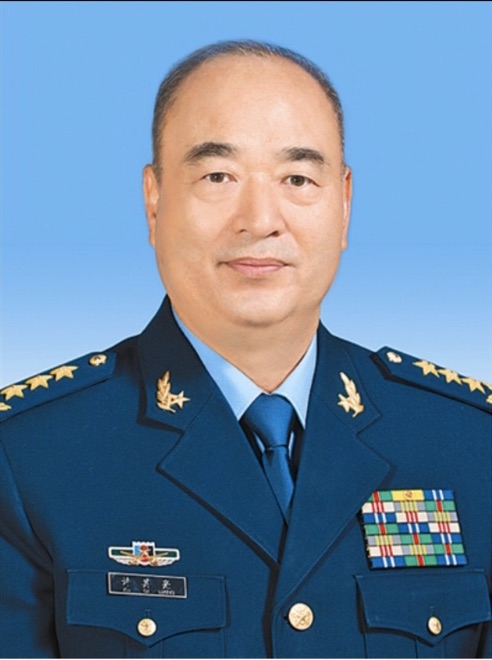
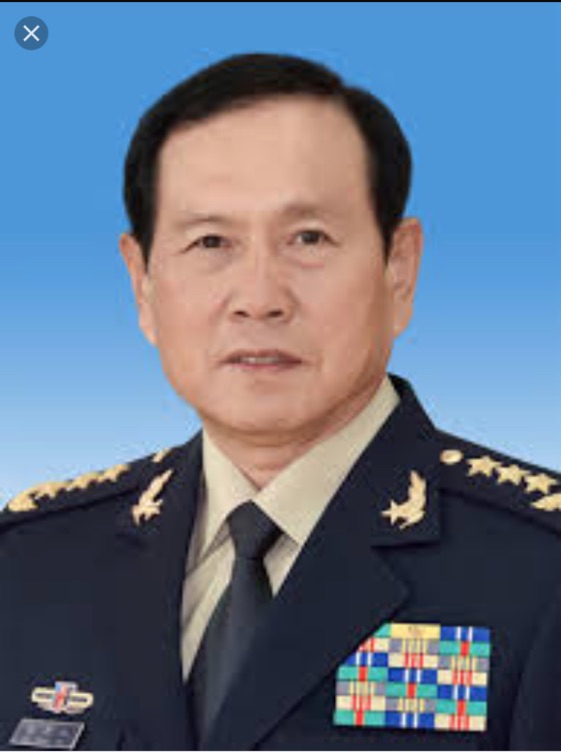
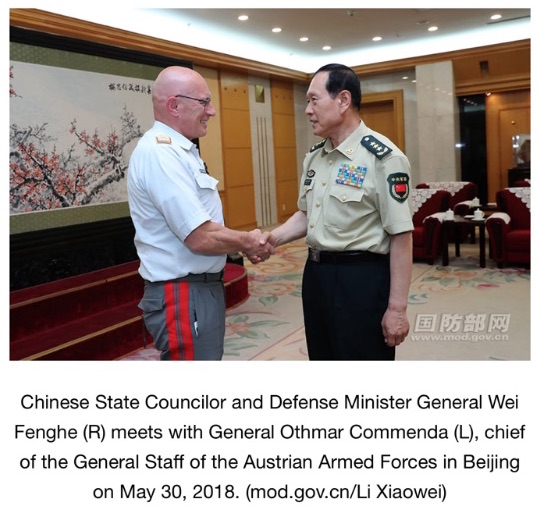
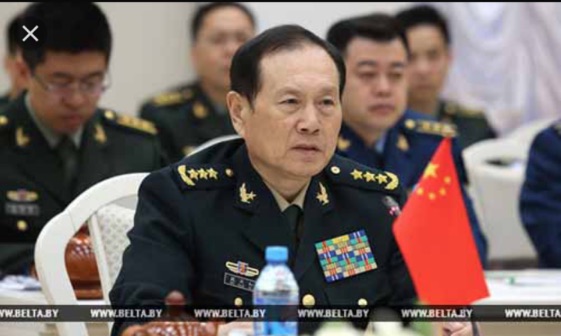

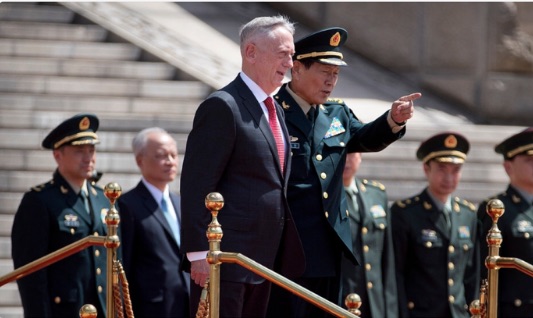
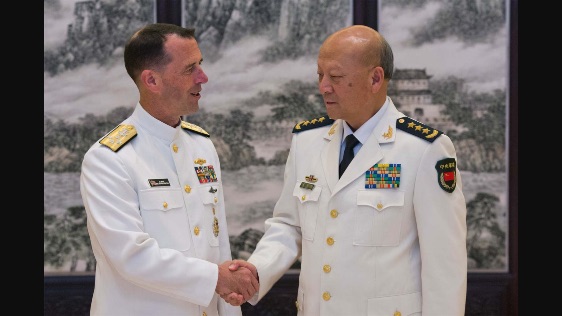
Sergey said,
June 28, 2018 @ 8:08 pm
You need to realize that the most gaudy examples found by the link for the Russia are not actually the military officers but essentially theatricals (or maybe cosplay would be a better word). The WWII Victory Day celebration has become a major part of the ideology of the current Russian government, including a military parade and a "parade of veterans". However the real WWI veterans are almost completely dead by now, so the people in the parade are cosplayers rather than the actual veterans. There have been articles in the internets analysing and exposing the fakeness of the medal racks of these fake veterans.
Kaskalu said,
June 28, 2018 @ 9:01 pm
I think Wikipedia itself has the answer here, in the article on Orders, decorations, and medals of China: “All ribbons except for the rank/billet ribbon centered at the top row are used to represent the wearer's length of service”. Indeed in those photos it looks like the top-center ribbon is one of the yellowish high-level rank ribbons from that page, and the rest are a whole lot of service years counted out in an arrangement of various ribbons.
ksana said,
June 29, 2018 @ 2:36 am
Here is link about the ribbon racks of PLA (in Chinese):
http://www.360doc.com/content/14/0306/17/10983756_358275010.shtml
The service-year ribbons on the racks (total minus 2) have 6 patterns representing respectively 1, 2,3,4,5 and 10 years of service. These ribbons are added together to represent the years of service in the military. As a member of the Military Committee of CPC is designated 7 rows and 3 columns, which means 19 ribbons are added up, 1 to 4-year patterns are mostly used. It may explain the similarities of these generals' ribbon racks.
tangent said,
June 29, 2018 @ 4:41 am
That's very interesting, Kaskalu, so by that they do not include personal decorations or awards at all. But are those forborne entirely, or represented in some different form?
Dave said,
June 29, 2018 @ 5:05 am
Semiotically, I'd noted a strong optical resemblance of the signs carried in the «Бессмертный полк» (with pictures of ancestors … and brief information about their WWII service?) to the ikons carried aloft in Orthodox (cf spanish catholic) processions; do they carry similar meanings?
If we view the evolution of martial commemoration as a process of abstraction over time: from bas-reliefs proclaiming deeds to medals around the neck to ribbons on the chest, then the PRC has abstracted yet further, down to rank/length of service. Not exactly wearing one's heart on one's sleeve…
ajay said,
June 29, 2018 @ 5:56 am
That's very interesting, Kaskalu, so by that they do not include personal decorations or awards at all. But are those forborne entirely, or represented in some different form?
It's quite possible that none of these generals have any. The PLA's last foreign campaign was in 1978 (its disastrous attempt to invade Vietnam). If you were a junior officer back then, you would now be at least 60; in fact, Zhang Youxia, effectively the PLA army chief of staff, is one of very few officers in the PLA with actual war experience. Since then, the PLA has confined itself to killing unarmed Chinese civilians, which probably doesn't earn you medals.
AKA said,
June 29, 2018 @ 8:49 am
@ajay In the US military the ribbons aren't necessarily associated with combat or actual war experience either. You often get one at the end of your tour at one command, or for something worthy of recognition like scoring especially well on an inspection. I personally went on a "deployment" that lasted exactly 91 days so everyone could get the 90 days at sea ribbon and it took us to the hostile foreign waters of… Canada.
stephen said,
June 29, 2018 @ 12:01 pm
My mother, whose memory was not always reliable, believed that USAAF personnel after crossing the Atlantic were taken to see a film about the Battle of Britain and immediately after awarded a medal in recognition of their harrowing experience.
It does seem to be fact that the US army has a Prisoner of War Medal: an Eastern European friend observed. they're the only army where you get given a medal for surrendering.
Victor Mair said,
June 29, 2018 @ 12:54 pm
From Jim Fanell:
After all my years interacting with the PLAN, I had never received an adequate and compelling explanation for the PLAN’s ribbons, but after my visit aboard FFG-515 in Kiel two weeks ago I finally got the story.
Simply put, the PLAN’s ribbons (and the rest of the PLA) are nothing more than the record of the years of service and rank of said individual.
Each ribbon is represented by a number of stripes (from 1 to 4). By simply adding each ribbon together tells you how many years of service said member has in their career with that military branch.
The only variable is the center ribbon on the top row which represents the member's rank. Typically this has some number of stars.
Compared to US and other nation’s military ribbons, we see a system that does not boast of a member's individual actions or Duty stations during their Career. There are no personal awards, no awards for service with specific units, and as you say, no recognition of performance under combat conditions.
So, what are we to make of this?
Well in certain respects, we see the PLA’s system is in keeping with their Marxist-Maoist roots of group over self. We also see that this system offers increased operational security as you cannot tell at a glance where an individual served or under what conditions.
HOWEVER…their system represents the soullessness of the Chinese Communist Party, one which does not inspire individual acts of heroism in the same way that the Western world has had for centuries.
Was it not Bonaparte who said, “For a few bobbles and trinkets, a man will follow me to the ends of the earth.” (my paraphrase)?
The USN has their own peccadilloes regarding ribbons on uniforms. It used to be you could tell the difference between a PACFLT and LANTFLT Sailor very easily. The LANTFLT Sailor would wear their full “rack” of ribbons everyday, while PACFLT Sailors would only wear our “top three”! Why? Well, it was because the WestPac Sailor understood their value wasn’t based on the salad on their chest, but by their operations at sea.
Speaking of operations at sea and this issue, it should be noted that when underway at sea USN personnel wear no such ostentatious ribbons.
My cut is the PLA’s practices mirror their Marxist-Maoist culture….
Teresa G said,
June 29, 2018 @ 2:18 pm
Just a note that while David Petraeus' ribbon rack is certainly enormous, it may not follow that it is mostly obscured by his lapel. Usually these racks are intentionally staggered so that the lapels won't obscure them.
Alan Gunn said,
June 29, 2018 @ 4:14 pm
Three of General Petraeus's ribbons did not " spill over onto the right side of his uniform." The ribbons on the right are unit citations, awarded to all the members of a unit that accomplished something noteworthy. They are not awards to a particular person.
Chris C. said,
June 29, 2018 @ 8:36 pm
@AKA — Hey, man. Beavers. You can't be too careful around those Canadian beavers.
zafrom said,
June 29, 2018 @ 9:29 pm
"Was it not Bonaparte who said, 'For a few bobbles and trinkets, a man will follow me to the ends of the earth.' (my paraphrase)?"
Possibly. In 2018 it could have been AJ Hinch, manager of the Houston Astros baseball team, currently leading with the fewest errors, only 30. (my compliments on another fascinating post)
Mark Metcalf said,
June 30, 2018 @ 2:46 am
Here's the link to an informative presentation (PDF) that explains the use of insignia and ribbons in the PLA:
https://www.junyu.org/wp-content/uploads/2017/06/MMBrief-RankGrade.pdf
David said,
June 30, 2018 @ 11:54 pm
HOWEVER…their system represents the soullessness of the Chinese Communist Party, one which does not inspire individual acts of heroism in the same way that the Western world has had for centuries.
REALLY? Then what should one make of the stories of martyrs found in children's text books, though the one's I've com across all come from the revolution and Korean War periods? Perhaps a medal for having served in TAM in 1989 would be a bit bizarre.
David Marjanović said,
July 1, 2018 @ 12:29 pm
Socialist equalization or not, I'm sure the PLA would award medals and ribbons for actions that could be presented as part of PL, as the USSR did, if there had been a war since 1978. The US is actually quite unusual these days in having a war or several every few years.
ajay said,
July 2, 2018 @ 5:03 am
Compared to US and other nation’s military ribbons, we see a system that does not boast of a member's individual actions or Duty stations during their Career. There are no personal awards, no awards for service with specific units, and as you say, no recognition of performance under combat conditions.
But there are. These exist under the Chinese system; there are medals for individual valour and for excellence in leadership. It's just that they aren't worn. (And, in the case of valour awards, very few people have them.) There are also campaign medals (including one for peacekeeping).